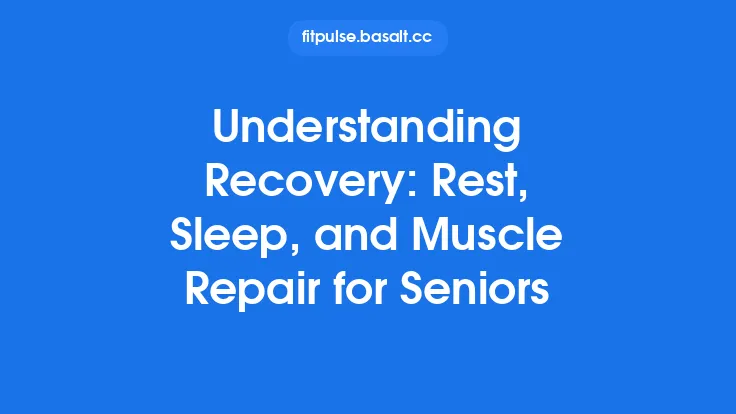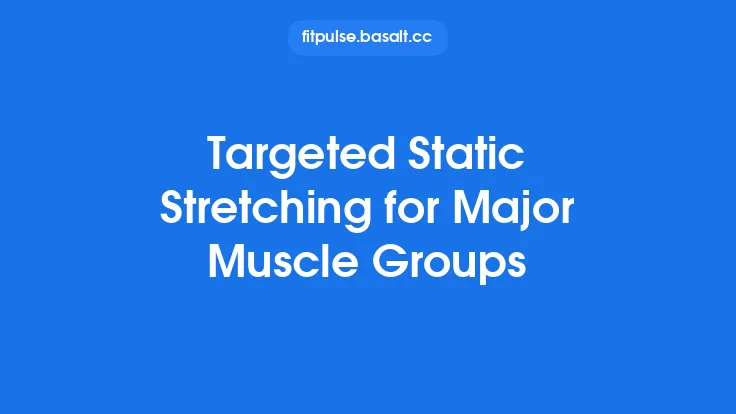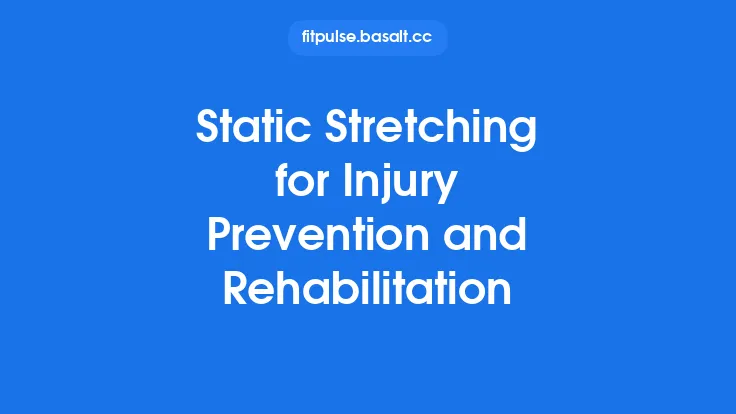After a demanding training session, the body is primed for repair, nutrient delivery, and the restoration of normal muscle tone. While many athletes instinctively reach for foam rollers, ice baths, or protein shakes, incorporating a dedicated static‑stretching segment can play a pivotal role in accelerating recovery and promoting genuine muscle relaxation. This article delves into the science, practical application, and nuanced considerations of using static stretching as a post‑workout recovery tool, offering an evergreen resource for anyone looking to enhance the restorative phase of their training cycle.
Why Static Stretching Aids Recovery
Static stretching—holding a muscle‑tendon unit at a point of mild discomfort for a sustained period—creates a cascade of physiological responses that are uniquely beneficial after exercise:
| Recovery Benefit | How Static Stretching Contributes |
|---|---|
| Reduced Muscle Stiffness | Prolonged elongation of the muscle fibers temporarily decreases passive tension, allowing the tissue to return to a more compliant state. |
| Enhanced Blood Flow | The sustained stretch induces vasodilation in the microvasculature, facilitating the delivery of oxygen, nutrients, and metabolic waste removal. |
| Neuromuscular Relaxation | Activation of Golgi tendon organs (GTOs) during a hold triggers inhibitory feedback to the alpha motor neurons, lowering muscle spindle activity and promoting a relaxed state. |
| Psychological Wind‑Down | The deliberate, mindful nature of static stretching encourages a transition from high‑intensity arousal to a calmer, recovery‑focused mindset. |
Collectively, these mechanisms help the muscle transition from a contracted, fatigued condition to a more relaxed, receptive environment for repair processes such as protein synthesis and glycogen replenishment.
Physiological Mechanisms Behind Muscle Relaxation
- Golgi Tendon Organ (GTO) Activation
When tension builds within a tendon during a static hold, GTOs fire afferent signals that travel to the spinal cord, where they inhibit the same motor neurons that caused the contraction. This autogenic inhibition reduces motor drive, allowing the muscle to “let go” of residual tension.
- Muscle Spindle Modulation
Muscle spindles are sensitive to changes in length and speed. A slow, controlled stretch minimizes spindle firing, preventing reflexive contraction (the stretch reflex) and fostering a more relaxed state.
- Viscoelastic Stress‑Relaxation
Connective tissue exhibits viscoelastic properties; under a constant load, stress within the tissue gradually declines—a phenomenon known as stress‑relaxation. Holding a stretch for 30–60 seconds capitalizes on this effect, permanently lengthening the tissue’s resting length for a short period.
- Endothelial Nitric Oxide Release
Mechanical deformation of the vascular endothelium during a stretch stimulates nitric oxide (NO) production, a potent vasodilator. Increased NO levels improve microcirculatory flow, which is essential for clearing lactate and delivering recovery nutrients.
- Hormonal Modulation
While the endocrine response to static stretching is modest compared to high‑intensity exercise, studies have shown slight elevations in growth hormone and reductions in cortisol when stretching is performed in a relaxed, post‑exercise context. This hormonal milieu can subtly support anabolic processes.
Optimal Timing and Duration Post‑Workout
| Variable | Recommended Practice | Rationale |
|---|---|---|
| When to Begin | 5–10 minutes after the main training stimulus, once heart rate has returned to near‑baseline (≈ 90–100 bpm) | Allows acute metabolic stress to subside, reducing the risk of exacerbating micro‑trauma. |
| Hold Length | 30–60 seconds per stretch, with 2–3 repetitions per muscle group | Balances sufficient time for stress‑relaxation and GTO activation without inducing excessive fatigue. |
| Total Session Length | 8–12 minutes for a full‑body routine | Provides enough coverage for major muscle groups while keeping the recovery window concise. |
| Frequency | After every intense training session; optional light session on rest days for chronic tension relief | Consistency reinforces the neuromuscular relaxation response and maintains tissue pliability. |
Note: The above guidelines are intentionally broad to accommodate a range of training modalities (strength, hypertrophy, endurance). Adjustments can be made based on individual soreness levels, training volume, and personal time constraints.
Integrating Static Stretching into Your Recovery Routine
- Cool‑Down Transition
Begin with a low‑intensity aerobic cool‑down (e.g., 3–5 minutes of light cycling or walking). This gradually lowers systemic stress hormones and primes the circulatory system for the subsequent stretch.
- Sequential Stretch Order
- Proximal to Distal: Start with larger, proximal muscle groups (e.g., hip flexors, hamstrings) before moving to distal structures (e.g., calves, forearms).
- Antagonist Pairing: Follow a stretch of a primary agonist with its antagonist (e.g., after stretching the quadriceps, stretch the hamstrings). This promotes balanced tension across joints.
- Breathing Technique
Adopt diaphragmatic breathing, inhaling to expand the rib cage and exhaling slowly while deepening the stretch. Controlled breathing enhances parasympathetic activation, further reducing muscle tone.
- Mindful Focus
Treat each hold as a brief meditation. Concentrate on the sensation of elongation, the gradual release of tension, and the rhythm of your breath. This mental component can amplify the relaxation response.
Combining Static Stretching with Other Recovery Modalities
| Modality | Synergistic Benefits with Static Stretching | Practical Integration |
|---|---|---|
| Foam Rolling (Self‑Myofascial Release) | Pre‑stretch rolling can reduce fascial adhesions, allowing a deeper static stretch. | Roll each target area for 30–45 seconds, then transition directly into the static hold. |
| Contrast Water Therapy | Alternating hot and cold immersion improves vascular shear stress; static stretching post‑contrast can lock in the increased range of motion. | Finish a contrast session with a brief static stretch of the most fatigued muscles. |
| Compression Garments | Sustained compression supports venous return; static stretching performed while wearing light compression can enhance proprioceptive feedback. | Wear compression sleeves during the stretch, ensuring they are not overly restrictive. |
| Active Recovery (Low‑Intensity Cycling, Swimming) | Maintains blood flow while static stretching provides the tension‑release component. | Perform 5 minutes of active recovery, then move to the static stretching block. |
| Nutrition Timing | Adequate protein and carbohydrate intake post‑stretch supports the anabolic window. | Consume a recovery shake within 30 minutes of completing the stretch routine. |
Practical Tips for Effective Post‑Workout Stretching
- Warm the Tissue First: Even though the session follows a workout, a brief “re‑warm” (e.g., 30 seconds of gentle dynamic movement) can improve stretch tolerance and reduce the perception of discomfort.
- Avoid Bouncing: Ballistic movements can reactivate the stretch reflex, counteracting the relaxation goal.
- Stay Within Mild Discomfort: A stretch should feel like a gentle pull, not pain. Pain signals potential micro‑damage, which is counterproductive during recovery.
- Use Props When Needed: Yoga blocks, straps, or bolsters can help achieve the desired hold without compromising form.
- Track Sensations: Keep a simple log noting perceived tightness, soreness levels, and any changes in range of motion. Over time, patterns emerge that guide adjustments.
- Hydration Matters: Adequate fluid intake supports tissue elasticity; aim for 500 ml of water within the first hour post‑exercise.
Common Pitfalls and How to Avoid Them
| Pitfall | Why It Undermines Recovery | Mitigation |
|---|---|---|
| Holding Stretches Too Long (>90 s) | Excessive duration can lead to over‑stretching of the connective tissue, increasing the risk of micro‑tears. | Stick to the 30–60 s window; if a muscle feels unusually tight, reduce the hold time. |
| Skipping the Cool‑Down | Abrupt cessation of activity spikes sympathetic tone, limiting the relaxation benefits of static stretching. | Incorporate at least 3–5 minutes of low‑intensity movement before stretching. |
| Stretching Only One Side | Asymmetrical tension can exacerbate postural imbalances and prolong recovery on the neglected side. | Perform stretches bilaterally, even if soreness appears unilateral. |
| Using Static Stretching as a Substitute for Rest | Over‑reliance on stretching cannot replace the restorative power of sleep and proper nutrition. | View static stretching as a complement, not a replacement, for comprehensive recovery strategies. |
| Neglecting Breathing | Shallow breathing maintains sympathetic activation, reducing the stretch’s calming effect. | Practice diaphragmatic breathing throughout each hold. |
Monitoring Progress and Adjusting Your Approach
- Range‑of‑Motion (ROM) Assessments
- Use a goniometer or smartphone inclinometer to measure joint angles (e.g., hip flexion, shoulder abduction) weekly.
- Incremental improvements (2–5°) indicate effective tension release and tissue adaptation.
- Subjective Soreness Scales
- Employ a 0–10 visual analog scale (VAS) for perceived muscle soreness before and after the stretch routine.
- A consistent reduction in VAS scores over several weeks suggests successful recovery integration.
- Performance Correlation
- Track key performance metrics (e.g., squat depth, sprint time) alongside stretch data.
- If performance plateaus or declines, consider reducing stretch volume or adjusting timing to avoid interference with acute training adaptations.
- Periodization Considerations
- During high‑intensity blocks (e.g., competition phases), shorten stretch duration to 20–30 s to minimize any potential interference with power output.
- In deload or off‑season periods, extend holds to 45–60 s to maximize relaxation benefits.
Closing Thoughts
Static stretching, when deliberately placed in the post‑workout window, serves as a low‑cost, low‑technology lever that can meaningfully accelerate recovery and foster genuine muscle relaxation. By understanding the underlying neuromuscular and vascular mechanisms, adhering to evidence‑backed timing and duration guidelines, and integrating stretching with complementary recovery tools, athletes and recreational lifters alike can transform the often‑overlooked cool‑down phase into a potent catalyst for long‑term performance and well‑being. Consistency, mindfulness, and periodic reassessment are the keys to unlocking the full restorative potential of static stretching.





